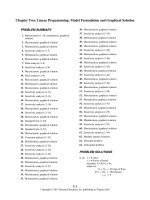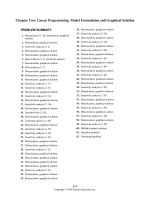Java how to program early objects 10th edition by deitel solution manual
Bạn đang xem bản rút gọn của tài liệu. Xem và tải ngay bản đầy đủ của tài liệu tại đây (906.05 KB, 8 trang )
jhtp_02_IntroToApplications.FM Page 1 Sunday, May 18, 2014 9:41 PM
Introduction to Java
Applications; Input/Output
and Operators
2
What’s in a name?
That which we call a rose
By any other name would
smell as sweet.
—William Shakespeare
The chief merit of language
is clearness.
—Galen
One person can make a
difference and every person
should try.
—John F. Kennedy
Objectives
In this chapter you’ll:
■
Write simple Java
applications.
■
Use input and output
statements.
■
Learn about Java’s primitive
types.
■
Understand basic memory
concepts.
■
Use arithmetic operators.
■
Learn the precedence of
arithmetic operators.
■
Write decision-making
statements.
■
Use relational and equality
operators.
jhtp_02_IntroToApplications.FM Page 2 Sunday, May 18, 2014 9:41 PM
Self-Review Exercises
2
Self-Review Exercises
2.1
Fill in the blanks in each of the following statements:
begins the body of every method, and a(n)
ends the body of
a) A(n)
every method.
ANS: left brace ({), right brace (}).
statement to make decisions.
b) You can use the
ANS: if.
begins an end-of-line comment.
c)
ANS: //.
,
and
are called white space.
d)
ANS: Space characters, newlines and tabs.
are reserved for use by Java.
e)
ANS: Keywords.
.
f) Java applications begin execution at method
ANS: main.
,
and
display information in a command wing) Methods
dow.
ANS: System.out.print, System.out.println and System.out.printf.
2.2
State whether each of the following is true or false. If false, explain why.
a) Comments cause the computer to print the text after the // on the screen when the program executes.
ANS: False. Comments do not cause any action to be performed when the program executes. They’re used to document programs and improve their readability.
b) All variables must be given a type when they’re declared.
ANS: True.
c) Java considers the variables number and NuMbEr to be identical.
ANS: False. Java is case sensitive, so these variables are distinct.
d) The remainder operator (%) can be used only with integer operands.
ANS: False. The remainder operator can also be used with noninteger operands in Java.
e) The arithmetic operators *, /, %, + and - all have the same level of precedence.
ANS: False. The operators *, / and % are higher precedence than operators + and -.
2.3
Write statements to accomplish each of the following tasks:
a) Declare variables c, thisIsAVariable, q76354 and number to be of type int.
ANS: int c, thisIsAVariable, q76354, number;
or
int c;
int thisIsAVariable;
int q76354;
int number;
b) Prompt the user to enter an integer.
ANS: System.out.print("Enter an integer: ");
c) Input an integer and assign the result to int variable value. Assume Scanner variable
input can be used to read a value from the keyboard.
ANS: value = input.nextInt();
d) Print "This
is a Java program"
on one line in the command window. Use method
System.out.println.
ANS: System.out.println("This is a Java program");
jhtp_02_IntroToApplications.FM Page 3 Sunday, May 18, 2014 9:41 PM
3
Chapter 2
Introduction to Java Applications; Input/Output and Operators
e) Print "This is a Java program" on two lines in the command window. The first line
should end with Java. Use method System.out.printf and two %s format specifiers.
ANS: System.out.printf("%s%n%s%n", "This is a Java", "program");
f) If the variable number is not equal to 7, display "The variable number is not equal to 7".
ANS: if (number != 7)
System.out.println("The variable number is not equal to 7");
2.4
Identify and correct the errors in each of the following statements:
a) if (c < 7);
System.out.println("c is less than 7");
ANS: Error: Semicolon after the right parenthesis of the condition (c < 7) in the if.
Correction: Remove the semicolon after the right parenthesis. [Note: As a result, the
output statement will execute regardless of whether the condition in the if is true.]
b)
if (c => 7)
System.out.println("c is equal to or greater than 7");
ANS: Error: The relational operator => is incorrect. Correction: Change => to >=.
2.5
Write declarations, statements or comments that accomplish each of the following tasks:
a) State that a program will calculate the product of three integers.
ANS: // Calculate the product of three integers
b) Create a Scanner called input that reads values from the standard input.
ANS: Scanner input = new Scanner(System.in);
c) Declare the variables x, y, z and result to be of type int.
ANS: int x, y, z, result;
or
int x;
int y;
int z;
int result;
d) Prompt the user to enter the first integer.
ANS: System.out.print("Enter first integer: ");
e) Read the first integer from the user and store it in the variable x.
ANS: x = input.nextInt();
f) Prompt the user to enter the second integer.
ANS: System.out.print("Enter second integer: ");
g) Read the second integer from the user and store it in the variable y.
ANS: y = input.nextInt();
h) Prompt the user to enter the third integer.
ANS: System.out.print("Enter third integer: ");
i) Read the third integer from the user and store it in the variable z.
ANS: z = input.nextInt();
j) Compute the product of the three integers contained in variables x, y and z, and assign
the result to the variable result.
ANS: result = x * y * z;
k) Use System.out.printf to display the message "Product is" followed by the value of
the variable result.
ANS: System.out.printf("Product is %d%n", result);
jhtp_02_IntroToApplications.FM Page 4 Sunday, May 18, 2014 9:41 PM
Exercises
4
2.6
Using the statements you wrote in Exercise 2.5, write a complete program that calculates
and prints the product of three integers.
ANS:
1
2
3
4
5
6
7
8
9
10
11
12
13
14
15
16
17
18
19
20
21
22
23
24
25
26
27
28
29
30
// Ex. 2.6: Product.java
// Calculate the product of three integers.
import java.util.Scanner; // program uses Scanner
public class Product
{
public static void main(String[] args)
{
// create Scanner to obtain input from command window
Scanner input = new Scanner(System.in);
int
int
int
int
x; // first number input by user
y; // second number input by user
z; // third number input by user
result; // product of numbers
System.out.print("Enter first integer: "); // prompt for input
x = input.nextInt(); // read first integer
System.out.print("Enter second integer: "); // prompt for input
y = input.nextInt(); // read second integer
System.out.print("Enter third integer: "); // prompt for input
z = input.nextInt(); // read third integer
result = x * y * z; // calculate product of numbers
System.out.printf("Product is %d%n", result);
} // end method main
} // end class Product
Enter first integer: 10
Enter second integer: 20
Enter third integer: 30
Product is 6000
Exercises
NOTE: Solutions to the programming exercises are located in the ch02solutions folder.
Each exercise has its own folder named ex02_## where ## is a two-digit number representing the exercise number. For example, exercise 2.14’s solution is located in the folder
ex02_14.
2.7
Fill in the blanks in each of the following statements:
are used to document a program and improve its readability.
a)
ANS: Comments.
.
b) A decision can be made in a Java program with a(n)
ANS: if statement.
statements.
c) Calculations are normally performed by
ANS: assignment statements.
d) The arithmetic operators with the same precedence as multiplication are
.
and
jhtp_02_IntroToApplications.FM Page 5 Sunday, May 18, 2014 9:41 PM
5
Chapter 2
Introduction to Java Applications; Input/Output and Operators
ANS: division (/), remainder (%)
set of parene) When parentheses in an arithmetic expression are nested, the
theses is evaluated first.
ANS: innermost.
f) A location in the computer’s memory that may contain different values at various times
.
throughout the execution of a program is called a(n)
ANS: variable.
2.8
Write Java statements that accomplish each of the following tasks:
a) Display the message "Enter an integer: ", leaving the cursor on the same line.
ANS: System.out.print( "Enter an integer: " );
b) Assign the product of variables b and c to variable a.
ANS: a = b * c;
c) Use a comment to state that a program performs a sample payroll calculation.
ANS: // This program performs a simple payroll calculation.
2.9
State whether each of the following is true or false. If false, explain why.
a) Java operators are evaluated from left to right.
ANS: False. Some operators (e.g., assignment, =) evaluate from right to left.
b) The following are all valid variable names: _under_bar_, m928134, t5, j7, her_sales$,
his_$account_total, a, b$, c, z and z2.
ANS: True.
c) A valid Java arithmetic expression with no parentheses is evaluated from left to right.
ANS: False. The expression is evaluated according to operator precedence.
d) The following are all invalid variable names: 3g, 87, 67h2, h22 and 2h.
ANS: False. Identifier h22 is a valid variable name.
2.10
Assuming that x = 2 and y = 3, what does each of the following statements display?
a) System.out.printf("x = %d%n", x);
ANS: x = 2
b)
System.out.printf("Value of %d + %d is %d%n", x, x, (x + x));
ANS: Value of 2 + 2 is 4
c)
System.out.printf("x =");
ANS: x =
d)
System.out.printf("%d = %d%n", (x + y), (y + x));
ANS: 5 = 5
2.11
Which of the following Java statements contain variables whose values are modified?
a) p = i + j + k + 7;
b) System.out.println("variables whose values are modified");
c) System.out.println("a = 5");
d) value = input.nextInt();
ANS: (a), (d).
2.12
Given that y = ax3 + 7, which of the following are correct Java statements for this equation?
a) y = a * x * x * x + 7;
b) y = a * x * x * (x + 7);
c) y = (a * x) * x * (x + 7);
d) y = (a * x) * x * x + 7;
e) y = a * (x * x * x) + 7;
f) y = a * x * (x * x + 7);
ANS: (a), (d), (e)
2.13 State the order of evaluation of the operators in each of the following Java statements, and
show the value of x after each statement is performed:
jhtp_02_IntroToApplications.FM Page 6 Sunday, May 18, 2014 9:41 PM
Exercises
a)
x = 7 + 3 * 6 / 2 - 1;
ANS: *, /, +, -; Value of x is 15.
b)
x = 2 % 2 + 2 * 2 - 2 / 2;
ANS: %, *, /, +, -; Value of x is 3.
c)
x = (3 * 9 * (3 + (9 * 3 / (3))));
ANS: x = ( 3 * 9 * ( 3 + ( 9 * 3 / ( 3 ) ) ) );
4
5
3
1
2
Value of x is 324.
2.19
What does the following code print?
System.out.printf("*%n**%n***%n****%n*****%n");
ANS:
*
**
***
****
*****
2.20
What does the following code print?
System.out.println("*");
System.out.println("***");
System.out.println("*****");
System.out.println("****");
System.out.println("**");
ANS:
*
***
*****
****
**
2.21
What does the following code print?
System.out.print("*");
System.out.print("***");
System.out.print("*****");
System.out.print("****");
System.out.println("**");
ANS:
***************
2.22
What does the following code print?
System.out.print("*");
System.out.println("***");
6
jhtp_02_IntroToApplications.FM Page 7 Sunday, May 18, 2014 9:41 PM
7
Chapter 2
Introduction to Java Applications; Input/Output and Operators
System.out.println("*****");
System.out.print("****");
System.out.println("**");
ANS:
****
*****
******
2.23
What does the following code print?
System.out.printf("%s%n%s%n%s%n", "*", "***", "*****");
ANS:
*
***
*****









